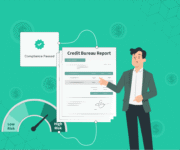Upselling to the existing customer base is a key pillar of the overall marketing strategy followed by lenders to increase Customer Lifetime Value and keep customer acquisition costs down. The spin-off effect on retention is an added benefit. However, traditional segmentation techniques based on demographics like income and location are barely sufficient to identify the right attributes in terms of credit behaviour and of course, the share of wallet. This is where credit bureau data becomes essential, offering deeper insights into creditworthiness and share of wallet.
According to the World Bank’s Global Findex Database Report 2025, 16% of bank accounts in India have had no activity for a period of 12 months or more. One of the reasons behind this is the tendency of Indian consumers to open multiple accounts with different service providers that they are not going to use in the future. This deprives the lenders of valuable data – spending history, annual income, and other insights – that could help them upsell value-added services to customers.
According to the Pitch Madison Report 2024, the BFSI sector contributed Rs 534 crore to overall advertising growth, as part of India’s total advertising industry that reached Rs 1.1 trillion in 2025.
However, in the absence of the correct data, it is difficult for lenders to determine RoI on their marketing spend. Rather than spending money to acquire new customers, NBFCs are looking to engage their existing customers to drive revenue growth.
Understanding How Credit Bureaus Help Lenders
Credit bureaus can help banks get greater visibility on the key attributes of a target audience to drive margins and improve service utilisation in a measurable and sustainable way.
Let’s take a look at the many ways in which lenders can leverage credit bureau data to provide greater value to customers in a relevant and timely fashion.
Utilising Direct Sales Agents More Effectively
Indian NBFCs rely on the direct sales channel to make up for their relatively less developed physical network. While DSAs do bring in a fair share of the overall revenues, a deeper understanding of key target segments can help them leverage the relationship factor to drive sales of higher-value products and services. They can then take on the role of consultants rather than affiliate sellers, increasing customer satisfaction and boosting financial inclusion in credit deprived segments.
Getting The Timing Right with Credit Bureau Data
Mobile marketing consultant, Localytics, studied customer opt-out rates related to push notifications and found some interesting ground realities – more than 91% customers unsubscribe to email communications, 44% email messages go unopened, and 60% do not click on mobile messages. This is ostensible because they are irrelevan,t and the frequency is very often excessive.
Though the segmentation strategy may be flawless, the response to outbound marketing campaigns can still be lukewarm. The reason: Lenders often fail to identify the right window of opportunity when a customer is most likely to top up a personal loan or invest in a home loan.
Credit bureau data can help lenders identify prospects for upselling based on the target customer’s external credit profile – third-party bank transactions or loan requests. They can then prioritize the leads that have the highest potential for conversion – for both consumer and business loans – and begin pitching to them before they are poached by competitors.
Micro-Targeting Pre-Approved Offers:
To increase conversion, banks and NBFCs have been successfully leveraging pre-approved offers for years. However, their efforts to upsell a customer – for example, on a home loan or balance transfer from another provider – may fall flat if they are not aware of the target audience’s payment history and outstanding debt. Many NBFCs use marketing lists sourced from various sources, which, in many cases, have wide gaps in terms of data related to financial history. This can impact both customer experience, in case a pre-approved offer is declined at the underwriting stage, and impact RoI.
Lending automation tools available today are making it possible for lenders to develop a 360-degree view of a target customer’s financial history. By combining credit bureau data with alternative credit scoring techniques, they can give lenders crucial insights.
Credit bureau data can also be leveraged to develop realistic customer personas that represent the ideal customer for a particular segment. This can reduce the time spent in pre-qualifying leads. Micro-targeting can improve loan approvals by up to 40%, according to Equifax.
Cross-Selling to SMEs
The SME sector, which contributes about 30% of India’s GDP and employs more than 40% of India’s workforce, is chronically short of capital. Due to the lack of liquidity in the market, NBFCs are averse to giving SMEs credit. The biggest reason is the lack of an established business credit history. At the same time, lenders happily approve loans for SMEs based on the owner’s personal credit bureau records. A low-hanging fruit is for lenders to cross-sell insurance and balance transfers to such customers.
The use of alternative credit scoring techniques can provide lenders with better visibility regarding the creditworthiness of the target audience and assure returns on investment.
Better Credit Risk Management with Credit Bureau Data
Needless to say, upselling a higher-value product entails a higher risk for lenders. Although retail loans have been faring far better than corporate loans in terms of NPAs, the rise in unemployment over the past few years can adversely impact revenues. Credit bureau scores can help lenders identify trends, including a drop in salary credits, late payments against other loans, and even foreclosures. This can help them take timely preventive action, such as lowering credit limits and offering settlements.
Upselling as a reactivation tool
As discussed earlier, India has among the world’s largest proportions of inactive bank accounts. This figure is twice as large as the global average of 25%. It represents a captive audience for NBFCs to re-engage and sell higher-value services. Apprehensions regarding bad loans can be mitigated through credit bureau data.
Lenders can bundle two or more services together in order to encourage inactive customers to start using dormant accounts again. This can help enhance overall utilization and bring customer attrition under control. A study by research firm Reichheld and Sasserll says that a mere 5% increase in retention can increase profits by up to 35% for financial service providers.
Conclusion
Upselling requires a gradual approach that takes into account customer aspirations and business objectives. Identifying triggers such as major life events- marriage, higher education, buying a house, a car, etc., is half the battle won. Credit bureau data, when combined with demographic attributes such as spending history and repayment status, can help financial institutions visualise potential risk liabilities more objectively.
The art of upselling requires a thorough understanding of buyer motives. Customer engagement can pay rich dividends, provided that lenders ditch the transactional mindset and develop a long term perspective. In fact, there are some platforms that can help lenders in these regards. For example, Finezza is a software and platform that comes with secure APIs and data pipelines that can be easily integrated into different banking systems. One unique feature that makes Finezza stand out among the rest is that it has every financial institution’s security needs factored in with its data-access controls.
Book a free demo to explore how Finezza’s features can make your loan management risk-free!




Leave a Reply